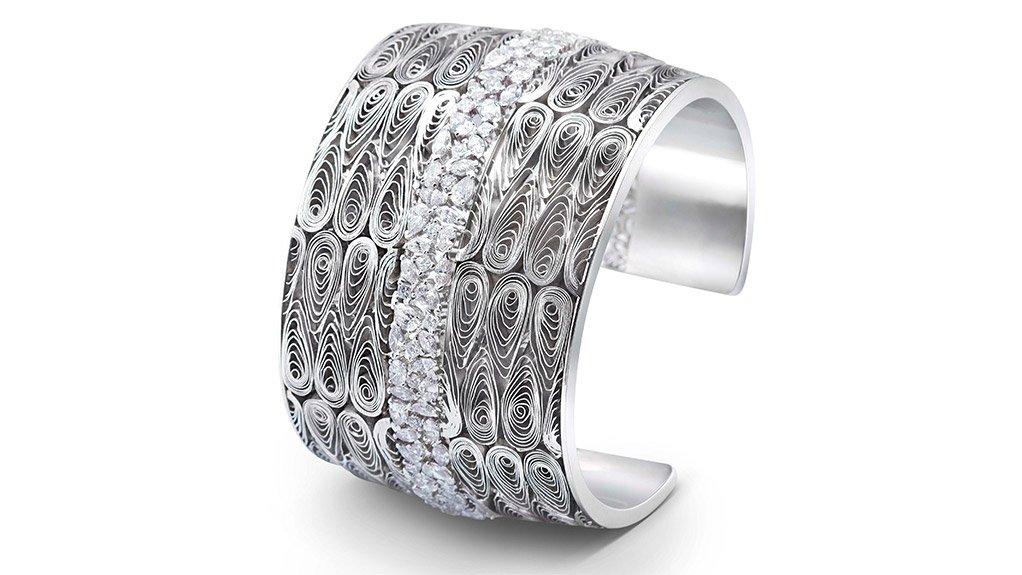Platinum jewellery had a strong fourth quarter, says the PGI
In the fourth quarter of last year, platinum outperformed other jewellery categories such as gold and delivered remarkable 14% year-on-year growth in fabrication.
The Platinum Guild International (PGI) reports that, although China’s economy ended on a high note in the fourth quarter, retail sales lagged as the sporadic outbreaks of Covid-19 hit store traffic.
The sales volume of the PGI retail partners increased by only 3% year-on-year in the fourth quarter, indicating a slower recovery in retail demand compared with fabrication.
Nonetheless, many retail partners seized the opportunity to promote platinum products, especially branded collections as they offer better margins and higher turnover rate.
PGI’s 2020 Platinum Moment collection posted double-digit growth in sell-in volume, supported by the development of new alloys and technologies led by the PGI.
At year-end, the PGI gathered market makers to showcase strong recovery cases and to share the latest technologies and design trends to lead the platinum industry in China forward.
China’s customs data showed that net platinum imports increased by 27% year-on-year in the fourth quarter, leading to a 22% increase to 84.7 t for the full year.
The PGI further reports that pent-up demand, coupled with buoyant enthusiasm during the festival season, led a 70% recovery in India’s jewellery industry by mid-November, compared with the festival season in 2019.
Strategic retail partners in the country cited significant sales growth in platinum in the fourth quarter, thanks to the “Season of Hope” targeted recovery programme launched in October with retail partners across 300 cities.
Smooth implementation of the Indian government’s latest directive for jewellers to sell only hallmarked jewellery from June 2021 onwards remains a challenge for the industry, especially for the unorganised players, as they will have to get their existing inventory hallmarked, the PGI points out.
This while Japan’s economy showed some resilience in the quarter under review, despite a resurgence in Covid-19 cases and a second declaration of a state of emergency in the country.
Store traffic recovered in October through to end November, while platinum jewellery unit sales were supported by a strong recovery in bridal and asset jewellery, as well as in department stores and nonstore channels.
Precious jewellery sales were up 0.4% year-on-year in the fourth quarter in value, but down 4.6% year-on-year in unit sales and up 5.3% year-on-year in average price, showing a positive mood despite the pandemic.
A campaign called Platinum Woman was launched in Japan to reposition platinum to the next generation of female consumers, through partner e-commerce sites and 200 physical stores.
Moreover, the PGI says the US economy faced the risk of a resurgent pandemic during the fourth quarter, but the jewellery industry nonetheless had a robust holiday season.
Platinum jewellery sales recovered most of the decline noted earlier in the year, driven particularly by higher-ticket bridal and diamond jewellery.
According to the Centurion Holiday Sales Success Index, 76% of jewellery retailers in 2020 reported an increase in holiday sales over 2019, and almost two-thirds of respondents said their total sales for the holiday season were at least 10% higher than in 2019.
The growth in jewellery sales through online channels has been especially prominent, as the industry has invested in technologies that ensure an omnichannel experience for their customers, which likely would not have happened in a normal year.
The PGI states that several US-based retailers sought the organisation’s support to capitalise on the more accessible platinum price, and consumers’ willingness to seal important relationships with a meaningful token. Some who worked primarily with white gold before have now started to promote platinum.
MARKET TRENDS
In the fourth quarter of last year, consumers in Japan, China, India and the US stated higher average expenditure on bridal jewellery through self-purchase, compared with the same period in 2019.
Indians and Americans state stronger year-on-year growth in average spending on bridal jewellery for self. This sentiment is reflected in the strong bridal jewellery sales especially among high-ticket items mentioned in the report.
For example, 54% of Indian respondents are planning to buy bridal jewellery such as an engagement ring or wedding band in the next 12 months, the highest among the four markets.
This while female self-buying continues to be strong; 77% of Chinese and Indian female respondents have bought non-bridal jewellery for themselves in the past 12 months, followed by 59% of American female consumers.
In the next 12 months, over 80% of Indian and Chinese female respondents plan to buy non-bridal jewellery for themselves, followed by 67% in the US.
Platinum continues to be strongly preferred by Chinese young consumers and all age groups in Japan. In China, platinum is most popular among Gen Z and Millennials aged between 18 and 45 – the future driver of jewellery consumption.
Younger Chinese consumers prefer platinum in jewellery not only to signify relationship milestones such as engagement rings, wedding bands and anniversary bands, but in a range of non-bridal types of jewellery, such as fashion rings, necklaces, earrings and chains.
Platinum is also strongly preferred by the Japanese, regardless of the jewellery type. The popularity of platinum among those aged between 46 and 55 in Japan is unrivalled, followed by younger women aged between 18 and 30.
In-store shopping is most preferred but under threat among Gen Z in China and the US.
Notwithstanding the effect of the global pandemic on global retail sales, visiting brick- and-mortar retail stores is still the most preferred channel for jewellery shopping, especially for Japanese and Indians, so the retail experience continues to play a key sales role in the sales process.
However, among those aged between 18 and 30, only 38% in China and 48% in the US prefer in-store shopping, while 28% in the US prefer buying precious jewellery online.
Thirty-six per cent of Chinese of this age group like shortlisting products online in advance of buying in stores. The ability to offer an omnichannel experience has seen increasing importance in those markets.
Comments
Press Office
Announcements
What's On
Subscribe to improve your user experience...
Option 1 (equivalent of R125 a month):
Receive a weekly copy of Creamer Media's Engineering News & Mining Weekly magazine
(print copy for those in South Africa and e-magazine for those outside of South Africa)
Receive daily email newsletters
Access to full search results
Access archive of magazine back copies
Access to Projects in Progress
Access to ONE Research Report of your choice in PDF format
Option 2 (equivalent of R375 a month):
All benefits from Option 1
PLUS
Access to Creamer Media's Research Channel Africa for ALL Research Reports, in PDF format, on various industrial and mining sectors
including Electricity; Water; Energy Transition; Hydrogen; Roads, Rail and Ports; Coal; Gold; Platinum; Battery Metals; etc.
Already a subscriber?
Forgotten your password?
Receive weekly copy of Creamer Media's Engineering News & Mining Weekly magazine (print copy for those in South Africa and e-magazine for those outside of South Africa)
➕
Recieve daily email newsletters
➕
Access to full search results
➕
Access archive of magazine back copies
➕
Access to Projects in Progress
➕
Access to ONE Research Report of your choice in PDF format
RESEARCH CHANNEL AFRICA
R4500 (equivalent of R375 a month)
SUBSCRIBEAll benefits from Option 1
➕
Access to Creamer Media's Research Channel Africa for ALL Research Reports on various industrial and mining sectors, in PDF format, including on:
Electricity
➕
Water
➕
Energy Transition
➕
Hydrogen
➕
Roads, Rail and Ports
➕
Coal
➕
Gold
➕
Platinum
➕
Battery Metals
➕
etc.
Receive all benefits from Option 1 or Option 2 delivered to numerous people at your company
➕
Multiple User names and Passwords for simultaneous log-ins
➕
Intranet integration access to all in your organisation





















